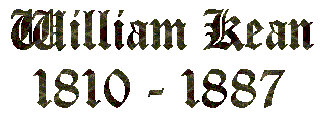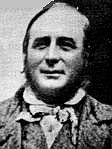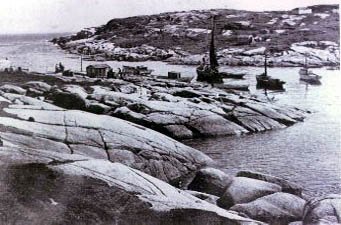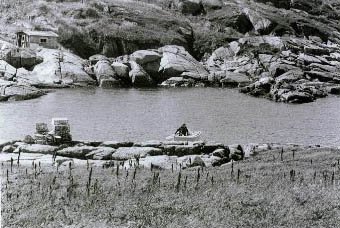
 William Kean |
William Kean was born in Flowers Island, Newfoundland on the 2nd of May 1810. He died in Pools Island, Newfoundland on the 1st of May 1887. He was married to Ann Janes on the 27th of June 1832 in Greens Pond, Newfoundland. Ann Janes was born on the 3rd of March 1815 in Big Pools Island, Newfoundland and died the 31st of July 1897 in Pools Island, Newfoundland. |
 Flowers Island, Newfoundland |
 Flowers Island, Newfoundland |
He had 13 children:
| Mary A Kean | b: 22 Mar 1833 b: 3 Jan 1834 b: 12 Sep 1836 b: 16 Jan 1838 b: 14 Jan 1840 b: 5 Nov 1842 b: 28 Nov 1843 b: 19 Oct 1845 b: 30 Oct 1847 b: 1 Aug 1849 b: 23 Aug 1851 b: 15 Apr 1853 b: 20 Aug 1885 |
d: 1 Jun 1834 d: unavailable d: unavailable d: 19 Sep 1906 d: unavailable d: 2 Jan 1884 d: 8 Jan 1914 d: 17 Mar 1880 d: unavailable d: 1930 d: unavailable d: unavailable d: 1960 |
|
decendant of William Kean, as am I)
Mariner; merchant. Born Flowers Island, son of Joseph and Mary Kean. Married Anne Janes. Kean was a pioneer sealing skipper out of Pool's Island, Bonavista Bay, where he was also the major merchant. A Labrador fisherman, sealer and schooner owner, Kean moved from Flowers Island to Main Pool's Island c. 1850. From his base in Pool's Island he was in charge of sea-going operations of one of the larger fishing and sealing firms in Bonavista North, in partnership with his brother Joseph, who remained based at Flower's Island. William Kean became the leading merchant and schooner-owner of Pool's Island and was the driving force in the building of St. James Church there in 1862. By 1871 the partnership owned four schooners (the Shaver, Gleaner, Emerald and Barbara) and was a leading factor in establishing Bonavista North as a centre for the Labrador fishery and the seal hunt. Kean's ability as a sealing master was acknowledged throughout Newfoundland and when the first two steamers went to the front in 1863 he was chosen by Grieve and Co. to take command of the Wolf. Many of the Bonavista North captains who later went on to long careers as sealing masters and Labrador skippers began under him (including his nephew, Abram Kean qv, whose autobiography describes his uncle as being a more significant influence than his own father). William Kean died at Pool's Island on May 2, 1887. L.G. Chafe (1923), Abram Kean (1935), E.R. Seary (1977), Naboth Winsor (1988), Newfoundland Historical Society (Pool's Island). RHC |
and a Sturdy Ship
By NABOTH WINSOR Among the sailing vessels engaged in the Newfoundland seal fishery during the last half of the 19th century, there were two barque-rigged vessels, the Ringwood and the Barbara. The Ringwood, commanded by Capt. Henry Norman of Brigus, was lost on her second trip. The Barbara, 162 tons, was built at Prince Edward Island in 1857. In 1860, she was owned and commanded by Capt. William Kean of Pool's Island, Bonavista Bay and was engaged in the seal fishery until 1880. Capt. William Kean was born at Flower's Island, Bonavista Bay in 1810. In 1843, he built at Flower's Island, a vessel, which he called The Young Shaver, 40 tons. Flowers Island consisted of two islands, Kean's Island and Sturge's Island, separated by a narrow tickle. Capt. Abram Kean, nephew of Capt. William, tells the story of the launching in his book "Old and Young Ahead." "The vessel was built head towards the water, her masts were put in place and all the rigging set up before she was launched. The morning she was launched was bitterly cold and just before the trip was knocked away my father appeared on the scene from the sail loft and said, "Bill, if you don't put something before the stem of this vessel, she will beat her stem out on the other island." "My father thought his own way best...the trip was knocked away and the big ice line that my uncle trusted to stop the schooner snapped like a thread that was burnt by fire, and just as my father predicted, the vessel beat her stem out on the other island. Nothing daunted, some men were placed at the pumps, others taking on board ballast and provisions and wood for kindling. The vessel then headed for Greenspond, where she was hove down and a new stem put in her. She sailed the seal fishery on the 9th day of March, and arrived at St. John's March 28 with a load of seals; sailed again for the second trip a few days after, arriving in St. John's April 28 with another load." Because of his successful voyages, in 1845 he had a larger vessel, the Gleaner, 79 tons, which, in 1847, had a catch of 1,600 seals. His next vessel was the Emerald, 111 tons, built at Wallace, N.S. in 1852. His voyage in this vessel in 1854 was 6,375 seals. His crew of 39 men made 51 pounds, eight shillings, nine pence, - approximately $250.00. The value of the voyage was $20,000.00. In 1860 he bought the Barbara which he commanded for 14 or 15 years. In 1871, her catch of seals was 8,100. In 1863, steamers were used in the Newfoundland seal fishery for the first time. There were two, the Bloodhound, commanded by Capt. Alexander Graham, and the Wolf, commanded by Capt. William Kean. The voyage for each ship was not successful. The Bloodhound's catch was 3,000, the Wolf's 1,340. Capt. Kean again took command of his beloved barque, the Barbara, and continued to do so until 1874, securing in most years good catches, when he took command of a new sealing steamer, the Micmac, 463 tons. He commanded her for two years. The second year her catch was 26, 569 seals. The Barbara was engaged in the seal fishery until 1880, but from the records available, we do not know if he commanded her after 1873. In August 1847, Capt. Kean moved from Flowers Island to Pool's Island, Bonavista Bay, where he lived until his death in May 1887. At Pool's Island, he established a mercantile business to supply his sealers and fishermen. In addition to the sealing vessels he commanded himself, he owned vessels commanded by his son, Capt. Benjamin Kean and others. He also owned schooners engaged in the Labrador cod fishery. He gave good leadership in his community and was the leading person in the building of St. James Anglican church, consecrated Sept. 24, 1865. The church is still being used and is in excellent condition. He was the first Clergy's Warden in the church. He was also a leader in education. In 1858, he asked one of his employees, Mr. William Murch, an Englishman, to 'teach the children.' Ther was no school in operation on the island. Capt. Kean paid him a salary until 1863 when Mr. Murch was employed by the Bonavista Bay North School Board, of which Captain Kean was a member. His beloved barque Barbara narrowly escaped destruction by fire when a fire swept through Safe Harbour in the 1870's. The vessel was moored in the snug harbour and men from Pool's Island, fearing the vessel was in danger, went to Safe Harbour and found that her rigging had caught. The fire was extinguished, the chains were slipped - there wasn't enough time to weigh anchor - and the vessel was taken safely to Pool's Island Tickle. We feel that this tribute should be paid to one of the early and highly successful sealing captains, vessel owner, industrialist and churchman of Bonavista Bay North. His sturdy barque, the Barbara, his pride, survived the storms, the rafting ice and all the other dangers met in pursuing the seal fishery. We have given a brief account of a courageous, industrious, wise sealing captain and a sturdy ship. |